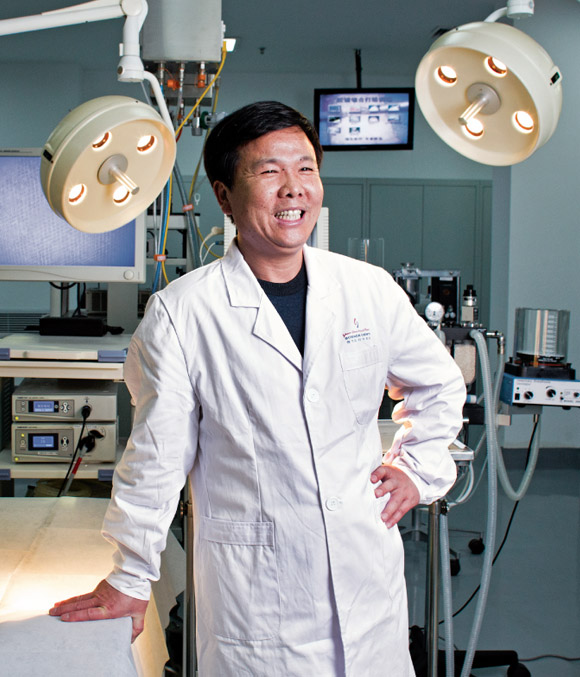
IMPROVING LIVES Surgeon Zhao Zhongliang is happy to be a part of making new technologies and better health care accessible to patients like those in the farming community he serves.
Local Insights Inspire New Products
Surgeon Zhao Zhongliang serves a farming community in China’s Hebei province. He recently worked with the Ethicon Endo-Surgery franchise to develop a new, market-appropriate surgical stapler to meet needs of patients like his.
Specialized surgical staples are often used to connect tissue during certain surgeries. They’re credited with quicker recovery times than suturing by hand. But in emerging markets, it often costs too much to use specialized equipment designed for developed markets. Dr. Zhao is excited about what the new surgical tool could mean for his patients.
“Patients who can now receive better health care at lower cost are certainly grateful,” he says. “Now, patients don’t carry the psychological weight of financial burden, so their recovery is complete.”
For a health care company passionate about meeting the unmet needs of hundreds of millions more patients, Johnson & Johnson needs to challenge its innovation capability to develop solutions that will be both appropriate and affordable. To that end, Johnson & Johnson is strategically basing research and development (R&D) centers in emerging markets to develop medical devices and pharmaceutical and consumer products based on insights available in local markets.
EMERGING MARKET NEEDS
The Asia Pacific region is home to more than 4 billion people, almost 60 percent of the world’s population. While the more affluent societies, such as Japan, Australia, coastal China and metropolitan India, have access to innovative products and services, a large segment of the population has been unable to access or afford much beyond a very basic level of health care until now.
Recent health care reforms in China and India, spurred by continuing economic growth in these countries, are creating possibilities for governments to deliver a higher standard of care to many more people. Such reforms, along with the rise of a middle class and expectations of a better quality of life, are providing Johnson & Johnson with an enormous opportunity to address a previously underserved market.
These mass markets are being addressed with a different business model that is focused on bringing an appropriate portfolio of technology and products to smaller and more rural health care settings, matching the specific range of procedures offered. This approach has led to the development of high-quality, affordable products that provide superior outcomes for patients who would not otherwise have access to such technology.
PASSION FOR INNOVATION
“Our vision is to be a source of innovation for emerging markets and address the unique needs of Asia Pacific patients,” says Michael del Prado, Company Group Chairman, Medical Devices & Diagnostics, Asia Pacific. “This might include devices for specific disease states that are prevalent in Asia, simplified and smaller instruments, multi-use or disposable products that are more economical, or a product range for rural health centers.”
In June 2011, a Medical Devices and Diagnostics R&D center will open in Suzhou, China, focused on market-appropriate innovation for fast-growing emerging markets. Functions to support this innovation will also be based on the campus, including new product development and marketing, clinical research, regulatory, quality assurance and operations.
Johnson & Johnson has also entered into pharmaceutical research partnerships that connect biotech, medical and academic communities to its global research centers. One is a partnership in cancer research formed in 2008 with Tianjin Medical University Cancer Hospital in China. In November 2010, a research collaboration between Tsinghua University in China and Janssen Pharmaceutica N.V. was announced. “This five-year strategic partnership aims to accelerate discovery research and foster new therapeutic approaches for infectious diseases, an area of significant unmet medical need and one where we feel we can contribute positively to public health goals in China,” says Kim Taylor, Company Group Chairman, Pharmaceuticals, Asia Pacific.
In 2009, Johnson & Johnson established a first-of-its-kind late-phase chemical entity facility, Analytical and Pharmaceutical Development Center, in Mumbai, India. The center will play a key role in addressing major global health care challenges, many of which also face Mumbai and the region.
For the consumer sector, the Emerging Market Innovation Center that opened in Shanghai in 2007 is built on a consumer closeness and bonding program, an integral part of emerging market product design and development to meet needs in China.
“I am happy Johnson & Johnson is focused on making new technologies and better health care accessible to lower-income patients,” says Dr. Zhao. “This results in better outcomes and fewer complications, really improving the lives of patients.”
